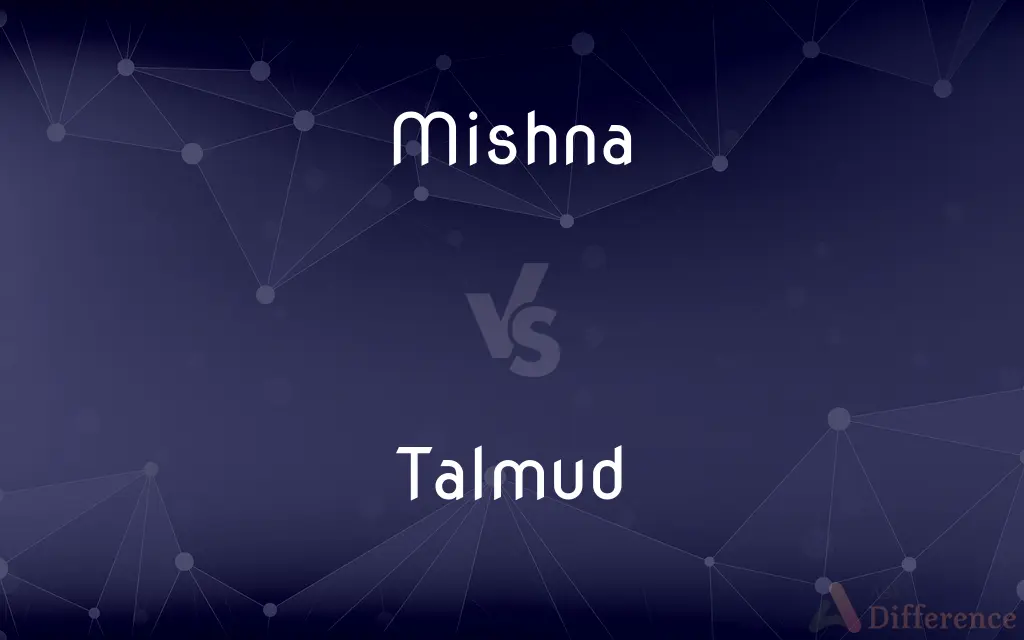Mishna vs. Talmud — What's the Difference?
By Urooj Arif & Fiza Rafique — Updated on April 1, 2024
The Mishna is the written form of Jewish oral traditions, while the Talmud includes the Mishna and its extensive rabbinical commentaries.

Difference Between Mishna and Talmud
Table of Contents
ADVERTISEMENT
Key Differences
The Mishna, compiled in the early 3rd century CE by Rabbi Judah the Prince, represents the first major written collection of Jewish oral laws and traditions. It organizes these laws into six orders, covering various aspects of Jewish life, law, and ethics. The Talmud, on the other hand, is a comprehensive record of rabbinical discussions regarding the Mishna, developed over several centuries. It consists of the Mishna and the Gemara, the latter being rabbinical commentary and analysis that expands, explains, and interprets the Mishna's teachings.
While the Mishna serves as a concise codification of Jewish oral law, the Talmud delves deeper, exploring the Mishna through debates, stories, legal reasoning, and ethical teachings. The Talmud exists in two versions: the Jerusalem Talmud, compiled in the 4th century CE in Palestine, and the Babylonian Talmud, completed in the 6th century CE in Babylon, with the latter being more extensive and widely studied in Jewish tradition.
The Mishna's structure and content are designed for memorization and teaching, providing a foundation for Jewish legal principles and practices. The Talmud's purpose is to interpret and expand upon the Mishna, incorporating centuries of rabbinical thought and debate. It plays a crucial role in the development of Jewish law, ethics, and theology.
In terms of study and application, the Mishna offers a direct insight into the codified oral traditions of Judaism, while the Talmud provides a broader context, including historical, cultural, and philosophical dimensions. The study of the Talmud is central to rabbinical scholarship, requiring extensive knowledge and interpretation skills, reflecting its complexity and depth compared to the Mishna.
Despite their differences, both texts are integral to understanding Jewish law and tradition. The Mishna lays the groundwork for rabbinical discussions, while the Talmud enriches and contextualizes those discussions, together forming the backbone of Jewish scholarly and religious life.
ADVERTISEMENT
Comparison Chart
Definition
Written form of Jewish oral laws and traditions.
Includes the Mishna and its rabbinical commentary (Gemara).
Compilation
Early 3rd century CE by Rabbi Judah the Prince.
Jerusalem Talmud in the 4th century CE, Babylonian Talmud in the 6th century CE.
Components
Six orders covering various aspects of life and law.
Mishna + Gemara (rabbinical debates and analysis).
Purpose
To codify Jewish oral traditions.
To interpret and expand upon the Mishna.
Study
Foundation for Jewish legal principles.
Central to rabbinical scholarship, more complex.
Influence
Provides a direct insight into Jewish legal tradition.
Broader context, including historical, cultural, and philosophical dimensions.
Compare with Definitions
Mishna
A codification of Jewish oral traditions.
The Mishna's structure facilitates memorization and teaching.
Talmud
Comprehensive rabbinical commentary on the Mishna.
The Talmud explores every aspect of the Mishna with in-depth discussions.
Mishna
Basis for rabbinical discussion.
The Mishna lays the groundwork for the Talmud's debates.
Talmud
Two versions: Jerusalem and Babylonian.
The Babylonian Talmud is more widely studied than the Jerusalem version.
Mishna
Organized into six orders.
The Mishna covers laws from agriculture to ethics.
Talmud
Reflects historical, cultural context.
The Talmud includes insights into the life and times of the rabbis who compiled it.
Mishna
Direct insight into Jewish law.
The Mishna offers a concise presentation of oral laws.
Talmud
Includes the Mishna and the Gemara.
The Talmud's Gemara provides extensive analysis of the Mishna.
Mishna
Early 3rd century compilation.
Rabbi Judah the Prince's work on the Mishna aimed to preserve Jewish traditions.
Talmud
Central to rabbinical scholarship.
Studying the Talmud is essential for understanding Jewish law and tradition.
Mishna
The first section of the Talmud, being a collection of early oral interpretations of the scriptures as compiled about AD 200.
Talmud
The Talmud (; Hebrew: תַּלְמוּד Tálmūḏ) is the central text of Rabbinic Judaism and the primary source of Jewish religious law (halakha) and Jewish theology. Until the advent of modernity, in nearly all Jewish communities, the Talmud was the centerpiece of Jewish cultural life and was foundational to "all Jewish thought and aspirations", serving also as "the guide for the daily life" of Jews.The term "Talmud" normally refers to the collection of writings named specifically the Babylonian Talmud (Talmud Bavli), although there is also an earlier collection known as the Jerusalem Talmud (Talmud Yerushalmi).
Mishna
A paragraph from this section of the Talmud.
Talmud
The collection of ancient Rabbinic writings consisting of the Mishnah and the Gemara, constituting the basis of religious authority in Orthodox Judaism.
Mishna
The teaching of a rabbi or other noted authority on Jewish laws.
Talmud
The body of the Jewish civil and canonical law not comprised in the Pentateuch.
Mishna
A collection or digest of Jewish traditions and explanations of Scripture, forming the text of the Talmud.
Talmud
The collection of ancient rabbinic writings on Jewish law and tradition (the Mishna and the Gemara) that constitute the basis of religious authority in Orthodox Judaism
Mishna
The first part of the Talmud; a collection of early oral interpretations of the scriptures that was compiled about AD 200
Common Curiosities
What is the significance of the Gemara?
The Gemara is significant for its in-depth analysis and interpretation of the Mishna, adding layers of understanding and context to Jewish law.
What does the Talmud include?
The Talmud includes the Mishna and the Gemara, with the latter being rabbinical commentary and analysis that expands on the Mishna.
Can one study the Talmud without knowing the Mishna?
While it's possible, understanding the Mishna is essential for grasping the context and depth of the Talmudic discussions.
Why is the Mishna important?
The Mishna is important as it codifies Jewish oral traditions, serving as a foundation for Jewish legal principles and practices.
What role does the Talmud play in Jewish tradition?
The Talmud plays a crucial role in interpreting and expanding upon the Mishna, reflecting centuries of rabbinical thought, debate, and the development of Jewish law, ethics, and theology.
How do the Jerusalem Talmud and Babylonian Talmud differ?
The Jerusalem Talmud was compiled in the 4th century CE in Palestine, while the Babylonian Talmud, compiled in the 6th century CE in Babylon, is more extensive and widely studied.
What is the Mishna?
The Mishna is the first major written collection of Jewish oral laws and traditions, compiled in the early 3rd century CE.
How accessible are the Mishna and Talmud to non-scholars?
Both texts require study and interpretation to fully understand, but there are translations and resources available for non-scholars interested in exploring them.
What are the six orders of the Mishna?
The six orders cover agriculture, festivals, family laws, civil and criminal law, temple service, and purity laws.
How is the Talmud used in modern Jewish life?
The Talmud is central to rabbinical scholarship and education, influencing Jewish law, ethics, and cultural practices.
How do the Mishna and Talmud influence each other?
The Mishna provides the foundational text for the Talmud's discussions, while the Talmud enriches and contextualizes the Mishna's teachings.
Is the Talmud read in a specific order?
The Talmud is typically studied in a tractate-by-tractate basis, often in the order of the Mishna but with focus on specific discussions or legal principles.
Share Your Discovery

Previous Comparison
Guangdong vs. Guangzhou
Next Comparison
Slamming vs. SlapAuthor Spotlight
Written by
Urooj ArifUrooj is a skilled content writer at Ask Difference, known for her exceptional ability to simplify complex topics into engaging and informative content. With a passion for research and a flair for clear, concise writing, she consistently delivers articles that resonate with our diverse audience.
Co-written by
Fiza RafiqueFiza Rafique is a skilled content writer at AskDifference.com, where she meticulously refines and enhances written pieces. Drawing from her vast editorial expertise, Fiza ensures clarity, accuracy, and precision in every article. Passionate about language, she continually seeks to elevate the quality of content for readers worldwide.














































